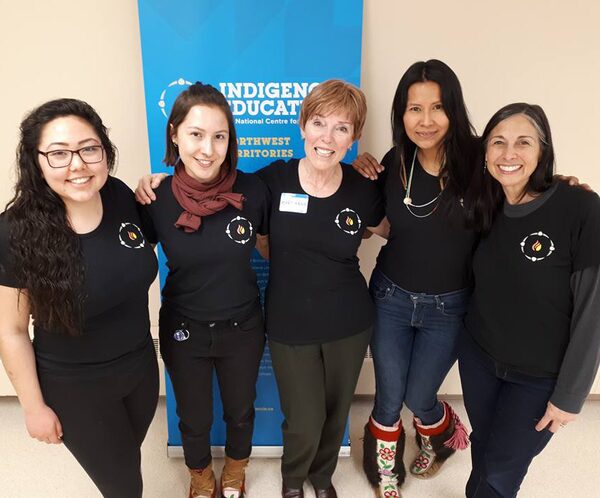
Student researcher Coty Zachariah (centre) speaks with Philip Abbot (left) and Linda Many Guns (right) at the NCCIE’s Ottawa forum
Coty Zachariah began teaching his daughter about her culture from the day she was born.
In some Mohawk communities, it is traditional to offer words of welcome in the Mohawk language just as babies are emerging into the world. Zachariah, whose father is from the Tyendinaga Mohawk Territory near Belleville, Ont., was determined to continue this tradition. So on the day his daughter was born, Zachariah spoke to the doctors about his wishes. They agreed to be quiet at the critical moment of birth, so that the first words his daughter heard would be in her ancestral language.
As the “proud father of a Mohawk girl,” it was a special moment for Zachariah, and emblematic of his belief that indigenous children need exposure to their own languages as they grow up.
“It’s learning how to live and dream in the languages,” said Zachariah. “Learning the culture and natural knowledge. Learning the rules of the community.”
Zachariah shared his story at a recent forum in Ottawa hosted by the National Centre for Collaboration in Indigenous Education (NCCIE). The NCCIE is an initiative of First Nations University of Canada (FNUniv), a federated college of the University of Regina that specializes in indigenous knowledge.

The NCCIE’s Yellowknife research team (left to right) Miriame Giroux, Jiah Sibbeston-Marlowe, Mary-Anne Neal, Melaw Nakehk’o and Jennifer Dockstator
The goal of the NCCIE is to gather stories of indigenous education across Canada and share those stories both in community forums and on their website (nccie.ca). The ultimate aim is to create a Canada-wide network of indigenous education by celebrating success stories and sharing best practices.
Zachariah, a student at FNUniv, was part of a panel of student researchers who were hired by the NCCIE to interview indigenous educators, elders and community members across the country. The researchers were invited to the Ottawa forum to share what they learned in the field, as well as give their own perspectives as young people who are “living” indigenous education.
One of the major themes that emerged at the forum was how indigenous education includes spending time on the land, learning from elders and knowledge holders. Salina Kemp, a Mi’kmac student at Saint Mary’s University in Halifax, spoke of her experiences growing up in the Millbrook First Nation in Nova Scotia. While Canadian elementary schools often tell children to sit down and listen, she said, indigenous communities instead ask their young ones to speak up.
“It’s learning by doing. Learning by questions. It’s sitting down with something and going, ‘Why is it this way?’” said Kemp. She recalled how her elders encouraged her to question things and form her own opinions about them, which she said made her a stronger student.
Amber Shilling, an Anishinaabe student at the University of British Columbia in Vancouver, said the experience of interviewing elders was “enlightening.” She spoke of the laughter and sense of humour in the people that she interviewed, but also noted that they had “complicated feelings about education,” dating back to the residential schools they were forced to attend.
It’s learning by doing. Learning by questions. It’s sitting down with something and going, ‘Why is it this way?’
— Student researcher Salina Kemp on being educated by indigenous elders
Amber Shilling, an Anishinaabe student at the University of British Columbia in Vancouver, said the experience of interviewing elders was “enlightening.” She spoke of the laughter and sense of humour in the people that she interviewed, but also noted that they had “complicated feelings about education,” dating back to the residential schools they were forced to attend.
As she completes her PhD in educational studies, Shilling said she feels she still must fight for indigenous ways to be acknowledged and accepted. “It’s exhausting to be an indigenous youth. We have so many responsibilities, which I think we happily [take on],” she said.
Shilling added that it can be “terrifying” to stand up for indigenous practices in the world of academia. “I’m so grateful for the trailblazers who came before and stamped on the grass and made it easier.’”
Zachariah noted that as an undergrad in indigenous studies, he’s been heartened to see the historical knowledge of indigenous peoples starting to be “normalized” in the Canadian post-secondary educational landscape. But the challenges faced by previous generations have not gone away, he said.
“Boys are made fun of for having braids. [Non-indigenous] kids are still making fun of [indigenous children] for speaking our languages. It’s something we still need to be aware of today.”
Schools need to be more accepting of indigenous education, said Zachariah, and more indigenous teachers and professors should be hired to improve the outcomes of indigenous students.
Kemp pointed out the importance of remembering that each indigenous nation is unique and needs to be respected as such. She noted that while their panel represented a coming together of several indigenous nations, the five people on stage couldn’t possibly represent the range of educational offerings out there. In each local environment, the spiritual teachings and languages will be different.
“It [can be] the same theoretical framework, but we really cannot lose sight of the fact that we have differences,” she said. “That’s what makes us special as individual nations.”
This content was produced by The Globe and Mail’s Globe Content Studio, in consultation with an advertiser. The Globe’s editorial department was not involved in its creation.